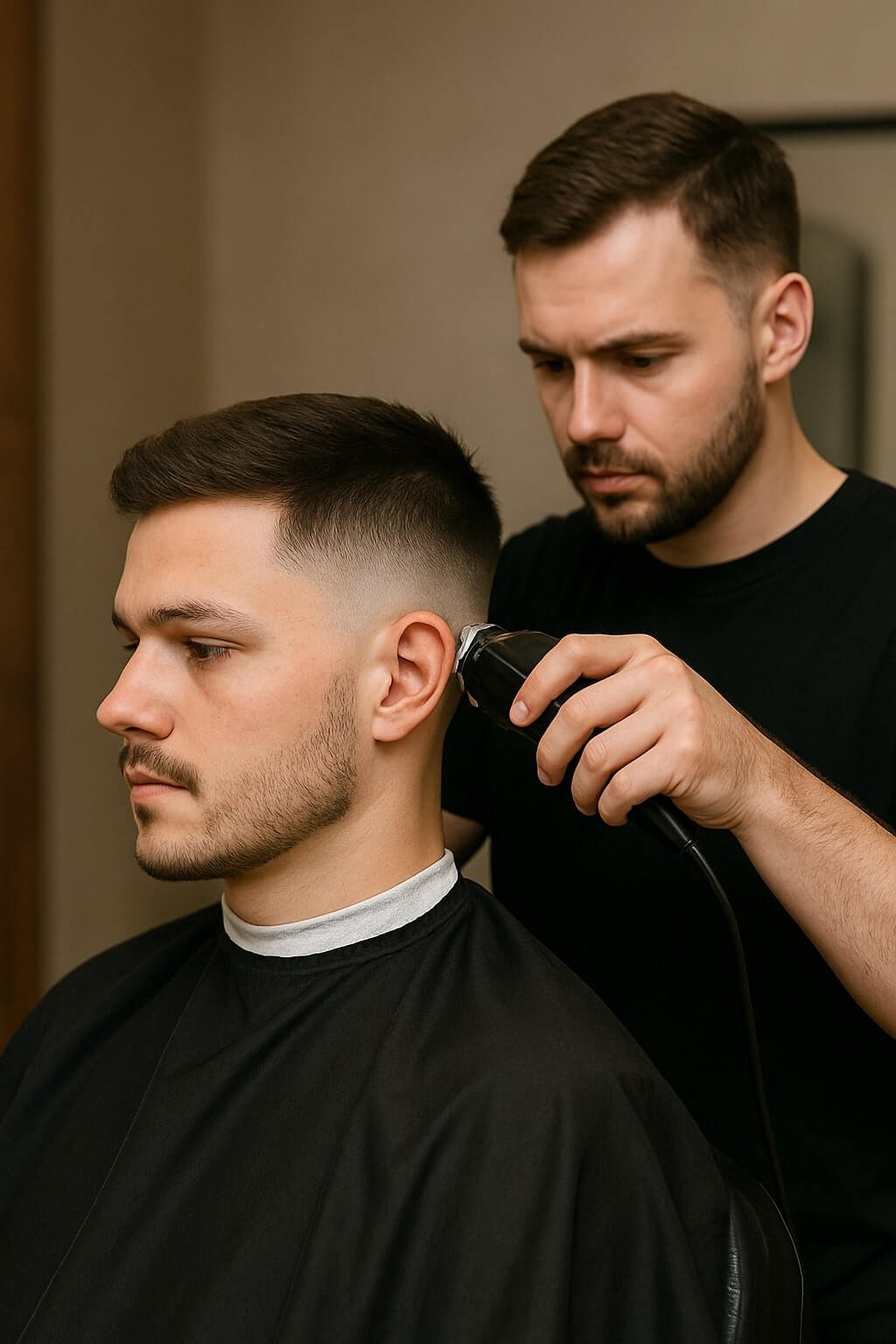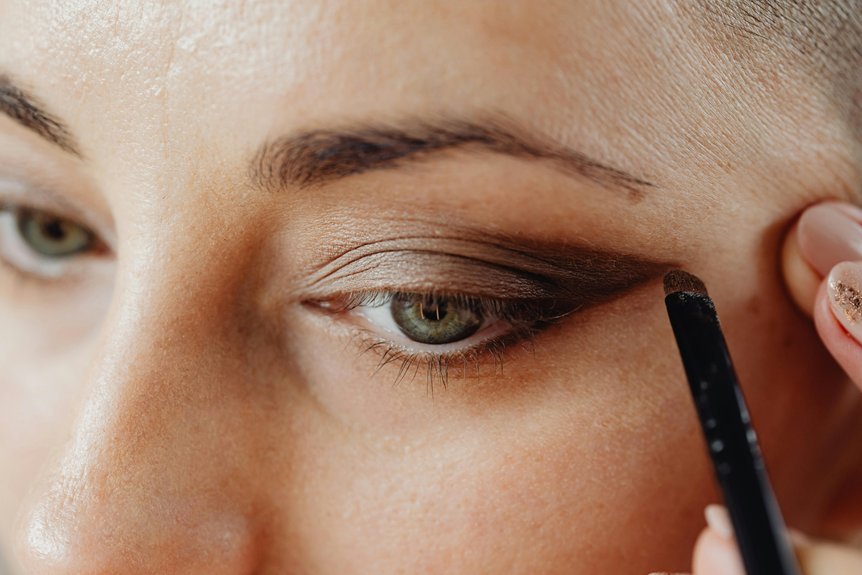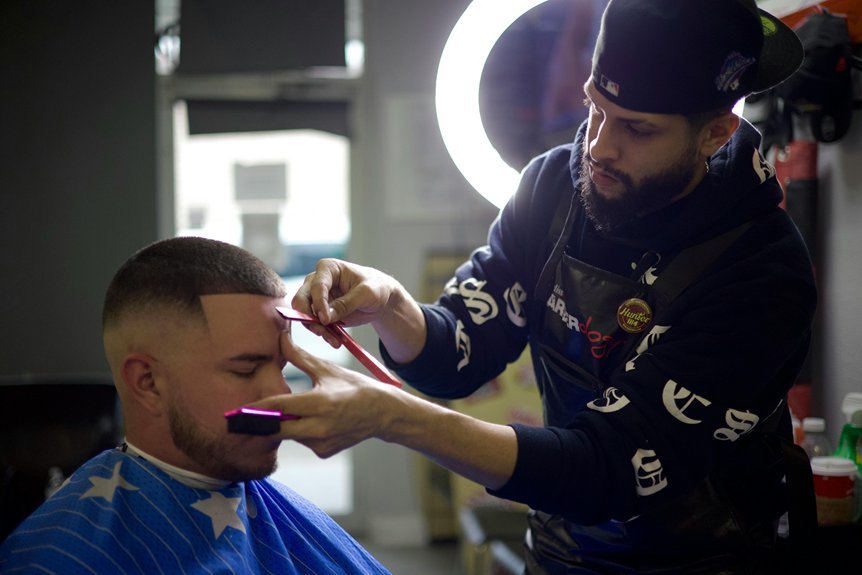You’re about to master the low taper fade by treating it like a system, not a guess. You’ll set clean guidelines, choose the right guards, and blend with disciplined strokes that respect head shape and symmetry. You’ll refine sideburns and the nape, then lock it in with sharp edgework and smart product choices. You’ll also learn when to maintain it and why seasons change your finish. Start with your tools—and one essential baseline.
Key Takeaways
- Understand the low taper fade: a gradual skin transition at temples and nape that preserves side bulk and complements most hair types.
- Prepare tools and hair: sanitized, zero-gapped clippers (guards 0–3), sharp shears, trimmers; cleanse, dry to damp, cape client, inspect scalp.
- Map guidelines: set a low baseline above ear hinge and nape curve, use light reference marks, ensure symmetry, and respect head shape.
- Blend and detail: clipper-over-comb to remove weight lines, maintain light pressure, crisp sideburns and nape, refine edges with trimmer and razor.
- Style and maintain: choose suitable product, apply with direction, finish with flexible spray, and schedule trims every 2–3 weeks for clarity.
Understanding the Low Taper Fade

Blueprint first: a low taper fade is a haircut where the hair gradually shortens from the temples and nape down to the skin, but only in the lowest half inch to inch above the hairline. You keep bulk on the sides and crown while sharpening the perimeter. That subtle drop creates a clean outline without exposing too much scalp.
You’re choosing one of the most adaptable fade styles. It flatters straight, wavy, and curly hair by framing the silhouette and emphasizing texture. Compared with higher fades, it preserves head shape and maintains professional polish.
In current haircut trends, it’s the go-to for seamless shifts into longer tops—quiffs, crops, parts, or curls. Map your contours: temple arc, sideburn length, and nape curve. Then decide your neckline—natural, tapered, or slightly boxed.
Tools and Clipper Guards You’ll Need
Before you start, assemble pro-grade clippers, a reliable trimmer, sharp shears, a taper lever, and a clean neck brush.
You’ll use guard sizes 0 to 3 most, with half guards (0.5, 1.5, 2.5) for seamless changes.
Keep your blades zero-gapped and your tools sanitized to lock in consistency and control.
Essential Barber Tools
Even with great technique, you won’t nail a clean low taper fade without the right tools.
Prioritize a streamlined kit and disciplined tool organization, so every motion supports precision hair cutting and modern barbering techniques. Keep your clipper blades aligned, oiled, and sanitized—consistent clipper maintenance protects performance and client safety.
Pair sharp barber shears with a fine-tooth comb for clean sections and controlled debulking. Finish with light, versatile styling products to reveal weight lines and texture. Your efficiency and customer service rise when your station is orderly and your tools are dialed to current haircut trends.
- Professional clippers and trimmers with adjustable levers
- Barber shears, razor, combs, and neck duster
- Disinfectants, oils, brushes, and blade guards
- Blow dryer, sprayer, sectioning clips, and capes
Recommended Guard Sizes
With your tools organized and tuned, choose guard sizes that map cleanly to your fade plan. You’ll anchor the low taper with a #2 (6 mm) on the parietal, step to a #1.5 (4.5 mm), then a #1 (3 mm), finishing the taper zone with a #0.5 (1.5 mm) and open lever. This guard length progression builds a clean gradient while protecting bulk.
- For coarse hair, start with a #3 (10 mm) to preserve weight.
- For fine hair, tighten jumps: #1.5 → #1 → #0.5 → open blade.
- Always detail the perimeter with no guard and a steady lever.
| Guard | Purpose | Feeling |
|---|---|---|
| #3–#2 | Keep structure | Confident |
| #1.5–#1 | Bridge density | Focused |
| #0.5–open | Blur line | Calm |
| Trimmer | Edge refine | Satisfied |
Use consistent strokes and cross-check to sharpen your fade techniques.
Preparing the Hair and Setting Up
A clean, well-mapped canvas sets up a flawless low taper fade. Start by shampooing to remove oils and product; prioritize hair health with a lightweight conditioner and thorough rinse.
Towel-dry to damp, then blow-dry with controlled airflow so strands lie in their natural direction. Focus on scalp care: inspect for irritation, bumps, or cowlicks that could affect machine contact and pressure.
Comb consistently to reveal growth patterns and density changes. Disinfect tools, attach your opening guards, and check blade alignment to prevent snags.
Comb methodically to read growth patterns; disinfect tools, attach opening guards, and verify blade alignment to avoid snags.
- Wash, condition, and dry to a consistent, workable state.
- Sanitize clippers, guards, trimmers, combs, and brushes.
- Oil blades lightly; test motor speed and heat.
- Seat your client upright, adjust lighting, and secure a clean cape with neck strips.
Mapping Your Guidelines
Before the clippers touch skin, define a clear roadmap for the low taper’s rise and flow. Anchor your baseline just above the ear hinge and along the nape’s natural curve—this is your lowest changeover.
Use a pencil comb or light trimmer marks to plot clean, symmetrical reference points. Prioritize guideline placement that respects head shape: keep it lower on flatter temples, slightly higher on rounder crowns to maintain balance.
Apply disciplined guideline techniques. Map the secondary guideline parallel to the baseline, leaving a measured buffer to preserve taper depth.
Mirror both sides by checking from the bridge of the nose outward. Mark the occipital bend to prevent the fade from creeping too high. Confirm continuity in good lighting, then lock your roadmap with minimal, precise reference strokes.
Creating the Initial Low Taper
Once your roadmap is locked, drop to a 0 or open 0.5 guard and set the lowest removal zone cleanly along the nape and just above the ear hinge.
Keep strokes tight and parallel to your guideline so the initial section stays controlled. Anchor the clipper with light pressure; let the blades, not your wrist, do the work. Maintain symmetry on both sides before moving forward with the fade technique.
1) Create a crisp baseline: trace the nape curve and mirror it around each ear, keeping the arc shallow and low.
2) Switch to corners of the blade to detail edges without climbing higher.
3) Feather the top edge of this section with short, upward taps—don’t chase bulk.
4) Recheck head tilt, lighting, and posture to protect balance and accuracy.
Blending and Removing Bulk
Now you’ll refine the shape with efficient clipper-over-comb, keeping the comb as your guide to control weight and create a seamless shift.
Use strategic debulking passes to remove mass without raising the fade, working in measured sections and checking symmetry after each pass.
Maintain light pressure, consistent stroke length, and clean corners so the blend stays tight and the silhouette remains intentional.
Efficient Clipper-Over-Comb
Refine the silhouette by using clipper-over-comb to blend weight lines and remove bulk with control. Anchor the comb at the heaviest area, tilt it slightly off the head, and run the clipper parallel to the comb’s spine. Keep strokes short, consistent, and deliberate to avoid steps. Calibrate blade speed and tension—too slow chews, too fast skates.
- Map changeover zones: identify where the fade shifts from skin to length, then target shadows with disciplined clipper techniques.
- Master comb positioning: pivot the comb to expose only the length you intend to cut; advance upward in micro-increments.
- Control angles: maintain a constant cutting plane; change the comb angle, not the clipper angle, to refine gradation.
- Verify symmetry: cross-check from multiple viewpoints, then lightly re-pass high spots to maintain a clean, seamless blend.
Strategic Debulking Passes
With your clipper-over-comb work setting a clean contour, shift focus to strategic debulking that preserves shape while freeing movement.
Map weight zones: temple ridge, parietal, and occipital corners. Use targeted debulking techniques, not blanket passes. With a closed 1.5 or open 1 guard, glide diagonally through the heaviest bands, keeping the blade parallel to the head to protect the taper’s flow.
Respect hair texture. On straight, dense hair, use controlled, overlapping passes to collapse corners. On wavy hair, stretch slightly and debulk with lighter pressure to avoid chattering. On coarse curls, pick out and chip away with clipper-over-comb for precision.
Constantly cross-check with the comb; stop when the section compresses uniformly. Finish by softening changes with thinning shears only where bulk resists blending.
Detailing the Sideburns and Nape
Although the taper sets the foundation, the finish depends on crisp sideburns and a clean nape. Focus your detailing after debulking, using light pressure and measured strokes.
Crisp sideburns and a clean nape complete the taper—detail lightly, with deliberate, measured strokes.
For sideburn shaping, mirror the face: square for angular jaws, slightly tapered for softer features. Keep lengths consistent with the temple fade so shifts read intentional, not abrupt.
For nape trimming, follow the natural growth pattern, removing bulk without pushing the neckline higher than the low fade’s base.
- Map reference points: ear top, jaw hinge, and lowest fade shelf to guide sideburn shaping.
- Use corners of the blade to refine arcs around the ear without gouging.
- Comb down, cut, then cross-check against the cheek line.
- For nape trimming, work center-outward to prevent asymmetry.
Edgework and Line-Up Techniques

Two goals drive edgework on a low taper fade: preserve natural contours and sharpen visibility where it counts. Anchor your guideline with a light pencil line, then refine with a trimmer held flat, not tilted.
Work in short strokes, clearing bulk before defining the perimeter. For line up precision, square the front only if the hairline supports it; otherwise, follow the natural curve to avoid premature grow-out.
Use corner-leading passes at temples and the C-cup to keep arcs tight and symmetrical. Float the blade along the parietal ridge so you don’t bite into the fade.
Stretch skin with your off-hand to stabilize and reveal true edges. Switch to a razor for final refinement, using minimal pressure.
Audit symmetry head-on, then profile.
Styling and Product Finishing
Clean edges set the stage; now you lock the look with controlled styling and the right finish. Work product from roots to ends, directing hair with deliberate tension to preserve the taper’s gradation. Keep bulk light near the temple and nape, and define movement only where the shape needs emphasis.
- Choose hold: light creams for natural flow; matte clays for texture; pomades for shine and sleek control; gels for crisp definition.
- Apply precisely: emulsify a pea-size amount, tap through the crown, then rake forward and down the fade to prevent product bands.
- Set structure: comb with the grain for polish, or pinch and lift for separation without disturbing the blend.
- Lock the finish: mist a flexible hairspray from 10–12 inches to seal styling techniques and reinforce line clarity.
Consider these targeted product recommendations.
Maintenance Tips and Growth Management
Even as the fade settles, you manage growth proactively to keep the silhouette tight and the blend intact.
Set a maintenance routine: schedule a trimming frequency of 2–3 weeks to preserve the taper’s graduation and edge clarity. Monitor hair growth patterns; if your sides sprout faster, book interim cleanups.
Prioritize scalp health with gentle exfoliation once weekly and balanced hydration. Use nourishing oils sparingly on dry zones, avoiding saturation near the taper to prevent collapse.
Targeted product recommendations: light matte paste for control, sea-salt spray for lift, and a non-greasy leave-in for softness.
Adapt to seasonal changes—heavier moisturizers in winter, lighter formulations in humid months.
Refine styling techniques: brush with grain to maintain flow, detail edges with a trimmer, and finish with a cool blow-dry to lock shape.
Conclusion
You’ve now got the blueprint to execute a clean, consistent low taper fade. Set your tools, prep thoroughly, and map precise guidelines tailored to head shape. Build the fade with controlled strokes, then refine—detail the sideburns and nape, sharpen edges, and finish with targeted product. Evaluate in multiple light angles. Maintain every 2–3 weeks, adjusting guard choices and styling to seasonal changes and hair density. With disciplined reps and small refinements, your fades stay crisp, balanced, and undeniably professional.



